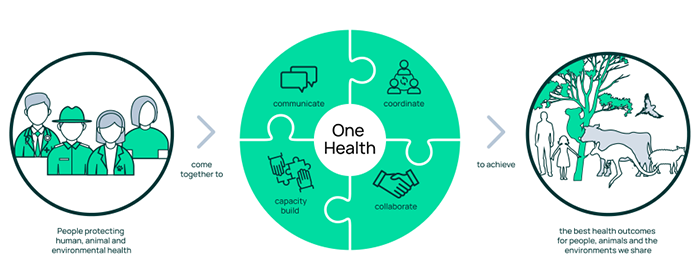World Environment Day is the perfect time for us to think about what we can be doing to protect and restore our natural environment. Working across health sectors, we regularly witness the positive impact of being in nature for patients and understand that a healthy eco system and flourishing natural environment are vital for our survival. This World Environment Day presents an excellent opportunity to take the time to learn more about One Health and the collaborative approach this concept can bring to the world we live in.
One Health is an integrated, unifying approach that aims to sustainably balance and optimise the health of people, animals, and ecosystems. It recognises that the health of humans, domestic and wild animals, plants, and the wider environment (including ecosystems) are closely linked and interdependent (World Health Organization, 2025).

Image: One Health, Australian Government Department of Health and Aged Care, Australian Centre for Disease Control (2025) – Visit source link
We can think of One Health as a multisectoral and transdisciplinary collaboration with a focus on the interconnections between people, animals, plants, and their shared environment (Australian Government Department of Health and Aged Care, 2025). This is important for us as health workers as understanding these interrelationships goes a long way to assisting with the management and prevention of diseases and environmental health issues.
The COVID-19 pandemic, as well as the Ebola and Zika virus outbreaks, are excellent examples of how human encroachment into wild areas, and interactions with animals and the environment, can have devastating health impacts. That is not to say that animals, plants, and the environment are dangerous to humans. On the contrary, they are essential to our ongoing survival. What needs to improve is the relationship we have with animals, plants, and the environment we share (Gruetzmacher et al., 2021).
Arenas such as “wet markets” and our increased propensity to travel and explore wild environments have seen wild and domestic animals and plants be in environments they were never supposed to be in together. This can then result in the much easier spread of infection and disease.

Image: The COVID-19 pandemic made us think differently about wet markets, forgetting that these spaces form an integral part of community culture in many parts of the world. We need to review and consider how these spaces can be safe, whilst still meeting the community needs. Koay.C.K. Chaminar Wet Market March 2010 – Visit source link.
Similarly, the plastics that we use every day in our practice as healthcare professionals are one of the major contributors to the plastic pollution problem. Plastic covers our equipment, and we also rely heavily on single-use plastics. We discard them regularly, and often dispose of unused equipment due to an expiry date. These products are manufactured using chemicals, such as the industrial chemical BPA, that are highly toxic to humans, animals, and the environment.
Due to the high consumption of plastic and the inappropriate disposal of plastic waste, plastics have become one of the biggest threats to the environment, animals, and humans. BPA levels are now found in river waters and in the Indian Ocean garbage patch (Bidashimwa et al., 2023).
As our natural surroundings continue to deteriorate, we will see worsening weather patterns and natural disasters such as floods, bushfires, and droughts. If we do not begin to change our practices now, we will also see the rise of new zoonotic and vector-borne diseases, as both new and previously known pathogens resurface.
So what does this mean for me as a nurse? What can I do?
On World Environment Day, you as a nurse have a valuable position in advocating for One Health approaches within your healthcare settings and through your nursing practices.
- This could include reducing waste through local sustainability projects such as plastic recycling initiatives, donating expired equipment to companies that repurpose it, and moving to more eco-friendly materials.
- For health organisations and hospital planners, this might include creating more green spaces within hospital environments. The impact would be twofold: first, by creating and preserving biodiverse areas; and second, by enhancing the physical, emotional, and spiritual health of patients (Schweitzer et al., 2004).
- Lastly, antimicrobial resistance is another critical aspect of a One Health approach, due to the spread of resistant microorganisms intertwined with human, animal, and environmental health. Most antibiotics used to treat humans are also used to treat animals. This requires us, as nurses, to maintain effective infection prevention and control measures in our practice, and to optimise the use of antimicrobial medications through responsible administration and disposal, guided by evidence-based guidelines (McEwen & Collignon, 2018).
As nurses, incorporating a One Health approach in our work means we understand that interconnected health systems can lead to better health outcomes for all.
Want to find out more from the expert?
Sharon Deem’s TEDx Talk One Health in an Age of Climate Change, Extinctions, and a Pandemic offers an engaging and insightful introduction to the One Health concept. It’s a valuable listen for anyone wanting to deepen their understanding of how human, animal, and environmental health are interconnected.
Sharon Deem is a wildlife veterinarian and epidemiologist whose life’s work has focused on the relationship between animals, humans, the environment, and the diseases we share. Her first book, Introduction to One Health: An Interdisciplinary Approach to Planetary Health, was published in 2019. Sharon discussed the pandemic while it was occurring in 2020, noting that its emergence had been predicted years earlier. Sharon is a conservationist for wildlife, and we, as nurses, can think of ourselves as conservationists for humans. As we know, we cannot do this alone. It requires a collaborative approach across all sectors and disciplines.
With thanks to ACN’s Disaster Health Faculty
This article was developed by members of the Australian College of Nursing’s (ACN) Disaster Health Faculty Leadership Team, whose expertise and commitment support the nursing profession’s critical role in disaster preparedness, response, and recovery. Disasters disrupt the normal functioning of communities, and Australian nurses are often among the first to respond—whether as part of a formal disaster medical assistance team or as spontaneous responders within their own communities.
The Faculty facilitates a network of like-minded Fellows and Members who share an interest in disaster health, providing opportunities to stay up to date with news, research findings, best practice, educational opportunities, and policy developments in this important field.
Chair: Ms Angela Sheedy MACN
Deputy Chair: Ms Cat Brewer MACN
Leadership Support: Ms Jaimee Oxford MACN
We thank them for their contributions to this important discussion on the role of nurses in strengthening disaster health response and building resilient communities.
Joining a Faculty is an exclusive benefit of ACN membership, offering access to a dynamic community of nurses shaping the future of the profession.
Not an ACN member yet? Become part of Australia’s peak professional nursing association to access this benefit and many more. Join today by completing the online membership form.
References
Australian Government Department of Health and Aged Care, Australian Centre for Disease Control. (2025). One Health. https://www.cdc.gov.au/topics/one-health
Bidashimwa, D., Hoke, T., Huynh, T. B., Narkpitkas, N., Priyonugroho, K., Ha, T. T., Burns, A., & Weissman, A. (2023). Plastic pollution: How can the global health community fight the growing problem? BMJ Global Health, 8, e012140. https://doi.org/10.1136/bmjgh-2023-012140
Gruetzmacher, K., Karesh, W. B., Amuasi, J. H., Arshad, A., Farlow, A., Gabrysch, S., Jetzkowitz, J., Lieberman, S., Palmer, C., Winkler, A. S., & Walzer, C. (2021). The Berlin principles on One Health – Bridging global health and conservation. Science of the Total Environment, 764, 142919. https://doi.org/10.1016/j.scitotenv.2020.142919
McEwen, S. A., & Collignon, P. J. (2018). Antimicrobial resistance: A One Health perspective. Microbiology Spectrum, 6(2), 1–26. https://doi.org/10.1128/microbiolspec.arba-0009-2017
Schweitzer, M., Gilpin, L., & Frampton, S. (2004). Healing spaces: Elements of environmental design that make an impact on health. The Journal of Alternative and Complementary Medicine, 10(1), 71–83. https://doi.org/10.1089/acm.2004.10.S-71
UN Environment Programme. (2025). Joint tripartite and UNEP statement on definition of “One Health”. https://www.unep.org/news-and-stories/statements/joint-tripartite-and-unep-statement-definition-one-health
World Health Organization. (2025). One Health. https://www.who.int/health-topics/one-health#tab=tab_1





